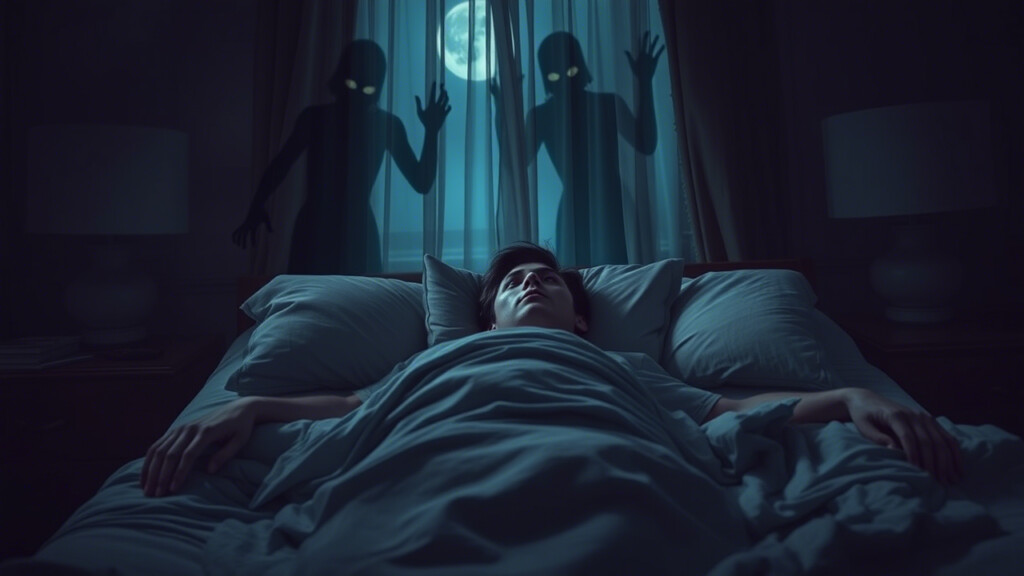Have you ever woken up in the middle of the night, unable to move, a numbness creeping down your spine, your chest feeling compressed, making it hard to breathe? In that instant, the first thought that flashes through your mind is: “I’m being held down by a ghost!” That sensation, both familiar and terrifying, seeps into dreams and becomes a lingering fear for many. But what exactly is sleep paralysis? Is it truly caused by “ghosts,” or is there something even more mysterious behind it?

Between Reality and Hallucination
For centuries, sleep paralysis has been draped in the cloak of the supernatural. Folklore tells tales of spirits pinning down their victims, wandering souls toying with the living, or “losing one’s soul” to the unknown. Shadowy figures looming in the darkness, whispering voices, and the suffocating grip of an invisible force—these chilling experiences have only fueled the fear surrounding this phenomenon.
However, what happens if we peel back the layers of mysticism? Science, with pioneering research from experts like Dr. Baland Jalal, identifies sleep paralysis as a neurological condition—essentially, a misalignment between the brain and body during sleep. In this peculiar state, your consciousness wakes up before your body does. Your mind is fully alert, but your muscles remain “asleep,” leaving you trapped in a motionless shell.
The Hidden “Culprit” Behind Sleep Paralysis
Imagine your sleep as a beautifully orchestrated symphony, with different movements playing in harmony. Among them, the REM (Rapid Eye Movement) stage is where our most vivid dreams occur. To prevent us from acting out our dreams, our brain temporarily disables voluntary muscle movement.
Sleep paralysis happens when there’s a “glitch” in this system. If you suddenly wake up during REM sleep, your brain regains consciousness, but your body remains paralyzed. This disconnect creates the terrifying feeling of being unable to move, as if an unseen force is holding you down.
Decoding the Haunting Hallucinations
But what about the eerie hallucinations—whispers, shadowy figures, and the sensation of being choked? These terrifying experiences are actually the result of a panicked brain trying to make sense of its paralysis. In its confusion, the brain reaches into the depths of your subconscious, pulling out buried fears and anxieties, which manifest as vivid hallucinations.
A study conducted by Italian researchers found that 38% of participants believed their sleep paralysis episodes were caused by a supernatural entity known as Pandafeche. This highlights how personal beliefs and cultural backgrounds play a crucial role in shaping one’s interpretation of the experience.
Turning Sleep Paralysis from Fear to Understanding
Understanding the science behind sleep paralysis is the first step toward overcoming its terror. Instead of panicking, try to remain calm, focus on your breathing, and remind yourself that it’s only a temporary state.
Maintaining a healthy lifestyle is also key to reducing the risk of sleep paralysis. Ensuring you get enough sleep, sticking to a regular sleep schedule, managing stress, and avoiding stimulants can all help prevent episodes. If you ever find yourself in a sleep paralysis state, try wiggling your toes or fingers, closing your eyes to minimize hallucinations, or concentrating on deep, steady breaths to regain control over your body.
Conquering Fear for a Peaceful Sleep
While sleep paralysis can be a terrifying experience, it is not a sign of supernatural interference. Rather, it is a minor “glitch” in the transition between sleep stages. Armed with scientific knowledge and a healthy sleep routine, you can banish these “uninvited guests” and reclaim peaceful, restful nights.
Do you think there are other unexplored aspects of sleep paralysis?
